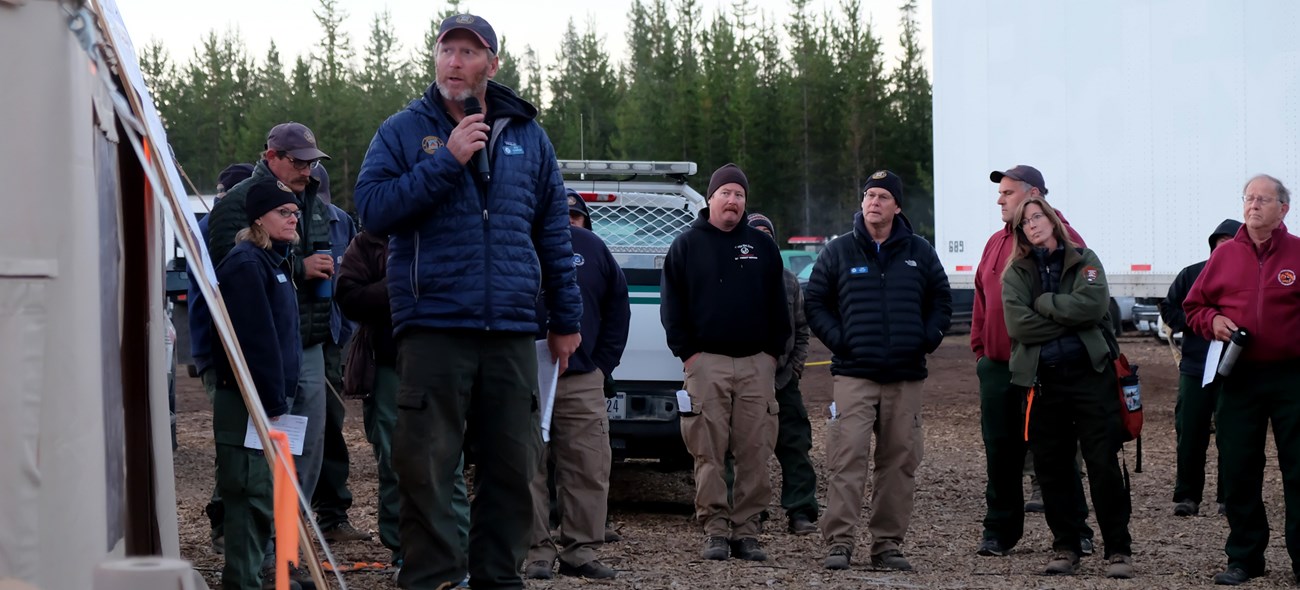Part of a series of articles titled Wildland Fire - Learning In Depth.
Article
Wildland Fire Incident Command System Levels
This article is part of the Wildland Fire Learning In Depth series. It is designed for students who want to learn more about fire. Find the complete series on the Fire subject site.
The Incident Command System (ICS) is flexible, scaling up or down as complexity and needs change. Type 5 is the least complex, while Type 1 is the most complex.

NPS
Levels and Types of ICS Management
Type 5: (very small wildland fire only)
- Initial attack
- Short duration, seldom lasting into the next burn period
- Few resources assigned (generally less than 6 people)
- Little complexity
Type 4
- Initial attack or first response to an incident
- IC is “hands on” leader and performs all functions of Operations, Logistics, Planning, and Finance
- Few resources are used (several individuals or a single strike team)
- Normally limited to one operational period
- Does not require a written Incident Action Plan (IAP)
- Examples: Search & Rescue (SAR), motor vehicle accidents, small fires
Type 3
- Extended initial attack on wildland fires
- IC walks the line between a manager and a 'doer'
- Resources may vary from several single resources to several task forces or strike teams
- Some Command/General Staff positions (ie, Division Supervisor, Unit Leader), may be filled
- May extend into another operational period (12 hours), and require an IAP
- Examples: Larger SAR’s, law enforcement incidents, special events, technical rescues, fires
Type 2
- IC spends all time being a manager
- Most Command and General staff positions are filled
- Large number of resources utilized
- Incident extends into multiple operational periods
- Base camp(s) established
- Significant logistical support is required
- Examples: Major fires, VIP visits, lengthy search and rescues, law enforcement incidents, multi-day special events
Type 1
- All functions are filled, plus leaders, branches etc.
- Multi-agency and national resources
- Large number of personnel and equipment are assigned to the incident
- It is a large, complex incident
- Examples: A major Incident—hurricanes, very large fires, natural disasters
The National Park Service supports and participates in interagency teams at both national and geographical area levels.
Area Command
Area command is established when an incident is so large that it must be divided and managed as two or more separate incidents; or when multiple, separate incidents with incident management teams (IMT) must be managed. The role of area command is to provide oversight direction to multiple incidents rather than providing direct action on any one incident as a Type 1 or Type 2 IMT would. Area command manages the efforts of various incident commanders (ICs) to ensure that the overall objectives are being met, to set priorities among incidents and to allocate scarce resources between incidents.
Summary of Definitions
Incident Command System—The management system used to direct all operations at the incident scene. The incident commander (IC) is located at an incident command post (ICP) at the incident scene.
Unified Command—An application of ICS used when there is more than one agency with incident jurisdiction. Agencies work together through their designated incident commanders at a single incident command post (ICP) to establish a common set of objectives and strategies, and a single Incident Action Plan.
Area Command (Unified Area Command)—Established as necessary to provide command authority and coordination for two or more incidents in close proximity. Area command works directly with incident commanders. Area command becomes Unified Area Command when incidents are multi-jurisdictional. Area command may be established at an Emergency Operations Center (EOC) or at a location other than an incident command post (ICP).
Multi-Agency Coordination (MAC)— Describes the functions and activities of representatives of involved agencies and/or jurisdictions who come together to make decisions regarding the prioritizing of incidents, and the sharing and use of critical resources. Multi-agency coordination is useful for regional situations. A MAC group can be established at a jurisdictional Emergency Operations Center (EOC) or at a separate facility.
Emergency Operations Center (EOC)—Also called Expanded Dispatch, Emergency Command and Control Centers, etc. EOCs are used in various ways at all levels of government and within private industry to provide coordination, direction, and control during emergencies. EOC facilities can be used to house Area Command and MAC activities as determined by agency or jurisdiction policy.
Last updated: May 30, 2025
